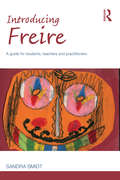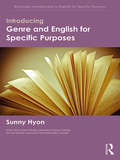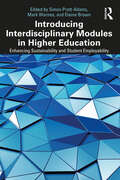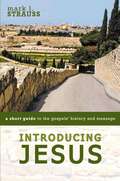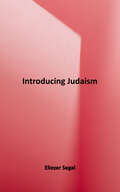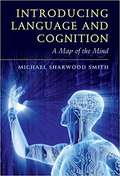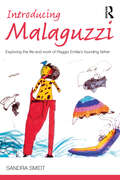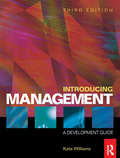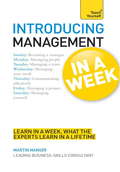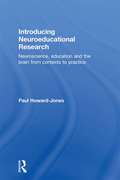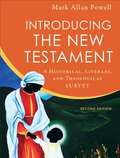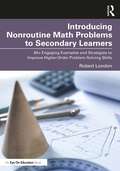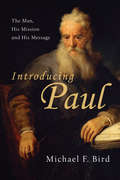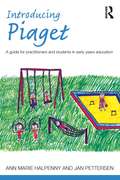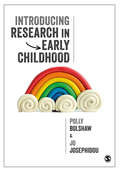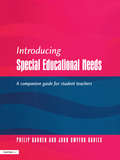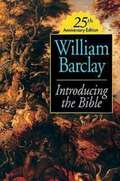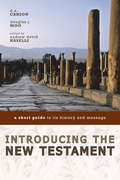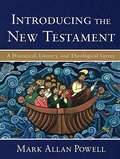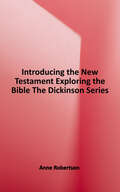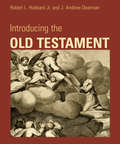- Table View
- List View
Introducing Freire: A guide for students, teachers and practitioners (Introducing Early Years Thinkers)
by Sandra SmidtThe famous Brazilian educator Paulo Freire has influenced educators, teachers and students in a broad tapestry of contexts and countries, as he challenged conventional thinking on how teachers ought to teach and learners ought to learn. By making his ideas accessible and relevant, this insightful and thought-provoking text draws out the relevance and topicality of Freire’s work and applies this to a wide range of educational settings, from adult education, through schools, to early years settings. Themes covered include: the lasting impact of illiteracy; the benefits and potential in becoming literate; literacy, language and power; the differences between banking and dialogic education; the social and political nature of learning. what kind of teaching and learning do we want? Using a variety of practical examples and case studies, Introducing Freire is an essential guide to the work of one of the most significant figures in education in the last century. Fascinating and accessible, this book is for anyone interested in teaching and learning, poverty and affluence, power and powerlessness, and society and change.
Introducing Genre and English for Specific Purposes (Routledge Introductions to English for Specific Purposes)
by Sunny HyonGenre analysis has become a key approach within the field of English for Specific Purposes and helps students understand particular language use patterns in target contexts. Introducing Genre and English for Specific Purposes provides an overview of how genre has been conceptualized and applied in ESP, as well as the features that distinguish ESP genre research and teaching from those of other genre schools. The macro and micro aspects of ESP genre-based pedagogy are also analysed and include: different possibilities for planning and designing an ESP genre-based course; the concrete, micro aspects of materials creation; and how genres can be learned through play. Introducing Genre and English for Specific Purposes is essential reading for students and pre-service teachers who are studying Genre, English for Specific Purposes or language teaching methodologies.
Introducing Interdisciplinary Modules in Higher Education: Enhancing Sustainability and Student Employability
by Mark Warnes Elaine BrownThis interdisciplinary book uses key examples and specific case studies from the ‘Trailblazers’ of Anglia Ruskin University, UK, to address the successes and challenges experienced during the creation, development, and running of breadth modules. It’s been carefully written to support anyone looking to implement this innovative method into their own university setting.With content informed by the United Nations Sustainable Development Goals, and using active learning pedagogies, interdisciplinary student teams work together to develop sustainable solutions, allowing for the growth of skills vital for enhancing student employability. The chapters are grounded in theory, making the discussions transferable to a wide readership interested in interdisciplinary approaches at the higher education level. The theoretical underpinnings of the discussions in each chapter will open up questions relating to contemporary issues such as diversity and representation, poverty and sustainability, artificial intelligence, and social justice.This is a must-read text for anyone seeking to implement similar breadth modules at their institutions, or considering how to develop strategies that address whole institution questions such as sustainability and employability.
Introducing Jesus: A Short Guide to the Gospels' History and Message
by Mark L. StraussTo Christians worldwide, the man Jesus of Nazareth is the centerpiece of history, the object of faith, hope, and worship. Even those who do not follow him admit the vast influence of his life. For anyone interested in knowing more about Jesus, study of the four biblical Gospels is essential.An abridged edition of the bestselling textbook Four Portraits, One Jesus by Mark Strauss, this simple, easy-to-understand guide introduces the four biblical Gospels and their subject, the life and person of Jesus.Like different artists rendering the same subject using different styles and points of view, the Gospels paint four distinctive portraits of the same remarkable Jesus. With clarity and insight, Mark Strauss addresses questions that surround the study of Jesus and the Gospels. What are the Gospels - are they history, theology, biography? Where did they come from? What do we know about their context? What does each Gospel uniquely teach us about Jesus? Finally, he pulls it all together illuminating what the Gospels together teach about Jesus' ministry, message, death, and resurrection, and how do we know we can trust their witness.Including questions at the end of each chapter for group discussion or personal reflection, Introducing Jesus makes the words, history, and context of the Gospels come alive for readers.
Introducing Judaism
by Eliezer SegalIntroducing Judaism is the ideal starting point for students beginning their studies of this fascinating religion. Eliezer Segal takes a historical approach, focusing on religious aspects of Judaism, and introducing themes as they emerge from authentic Jewish documents. Students will gain an understanding of how Judaism is lived by its adherents and the historical and geographical diversity of Jewish beliefs and practices. The book has a clear and accessible structure. Part One presents the historical context of Judaism, from the Biblical era, through the Medieval period and on to modern Judaism. Part Two surveys the distinctive values and beliefs of Judaism, including attitudes to God, Covenant, Israel, exile and homeland, the Torah, and its commandments, while Part Three presents Jewish Practices and Institutions, engaging with topics such as daily life, worship, temple and synagogue, law, ethics and education, the afterlife, and resurrection. Throughout the book, Eliezer Segal stresses the diversity of interpretations that have been generated by historical circumstances, differing theological and ideological outlooks, and the spiritual creativity of the religious community. Attention is paid to various models of piety, mysticism, scholasticism, and folk religion, including the impact of Judaism on the daily life of believers and the experiences of Jewish women. Illustrated throughout, Introducing Judaism includes text boxes, a glossary, and a list of further reading to aid students’ understanding and revision, providing a thorough overview of one of the first recorded monotheistic faiths and one of the oldest religions still practiced today.
Introducing Language and Cognition
by Smith Michael SharwoodIn this accessible introduction, Mike Sharwood Smith provides a working model or 'map' of the mind, with language as its centrepiece. Drawing on cutting-edge research across linguistics, psychology and neuroscience, it allows students to quickly grasp how each separate aspect of the mind's operations can be related. This 'big picture' view includes the way the mind makes, stores and loses memories of all kinds as well how its various 'expert systems' combine and collaborate to solve, typically beyond our conscious awareness, the myriad of tasks we are faced with every minute and millisecond of our existence. The book also focuses on language, that is, the mind of monolingual, bilingual and multilingual speakers. It will be of interest to all students wishing to learn more about the complex relationship between language - one of the most important ways in which we define ourselves as human - and the mind.
Introducing Malaguzzi: Exploring the life and work of Reggio Emilia’s founding father (Introducing Early Years Thinkers)
by Sandra SmidtLoris Malaguzzi is recognised as the founder of the extraordinary programmes of preschool education that developed after the war in Reggio Emilia, Italy. Deeply embedded in the cultures and communities they serve, these unique preschools have justifiably become famous throughout the world. In this accessible and engaging text, Sandra Smidt examines how Malaguzzi’s philosophy developed out of his personal experiences of growing up in post-fascist Italy. His ideas are explored and illustrated throughout by examples relating to everyday early years practice. The key themes explored include: relationships — the importance of relationships, culture and contexts to learning within any setting and beyond; transparency — the importance of listening and documentation to understanding and sharing learning; questioning — inviting children to not only answer questions but raise them, allowing them to be equal partners in all learning situations; creativity — finding ways of enabling children to use all the expressive languages they can find to express and share their ideas; equity and fairness — involving the community in all decision-making and discussions, to ensure that early childhood education is accessible and relevant to all children.? This book will be of benefit to all those working with young children and essential reading for students on early childhood education programmes.
Introducing Management: A Development Guide
by Kate WilliamsNow fully revised and in its third edition, this comprehensive best-selling text, Introducing Management: A Development Guide, explains the principles and practice of management and is ideal for both new and existing managers to assist them in their role. The text incorporates the latest innovations in management thinking and reflects the changes within the management standards. This is an essential resource for those undertaking qualifications at S/NVQ at Level 3.The learning development is clearly structured in each chapter to include:-Objectives, Insights, Case Studies, Examples, Review Your Learning, Back to Work, allowing the user to check their understanding and apply the concepts and principles to their own work situation.
Introducing Management in a Week: Teach Yourself
by Martin ManserThe ability to make a successful transition into management who wants to advance their career.Written by Martin Manser, a leading trainer of managers and highly-respected author, this book quickly teaches you the insider secrets you need to know to in order to seamlessly move up the career ladder.The highly motivational 'in a week' structure of the book provides seven straightforward chapters explaining the key points, and at the end there are optional questions to ensure you have taken it all in. There are also cartoons and diagrams throughout, to help make this book a more enjoyable and effective learning experience.So what are you waiting for? Let this book put you on the fast track to success!
Introducing Neuroeducational Research: Neuroscience, Education and the Brain from Contexts to Practice
by Paul Howard JonesAmongst educators, scientists and policy-makers there is a growing belief that the field of education can benefit from an understanding of the brain. However, attempts to bring neuroscience and education together have often been hampered by crucial differences in concepts, language and philosophy. In this book, Paul Howard-Jones explores these differences, drawing on the voices of educators and scientists to argue for a new field of enquiry: neuroeducational research. Introducing Neuroeducational Research provides a meaningful bridge between two diverse perspectives on learning. It proposes that any such bridge must serve two goals that are critically related to each other: it must enrich both scientific and educational understanding. This challenge gives rise to unique conceptual, methodological and ethical issues that will inevitably characterise this new field, and these are examined and illustrated here through empirical research. Throughout the book, Paul Howard-Jones: Explores ‘neuromyths’ and their impact on educational research Highlights the opportunities to combine biological, social and experiential evidence in understanding how we learn Argues against a ‘brain-based’ natural science of education Introduces clearly the concept of an interdisciplinary neuroeducational approach Builds a methodology for conducting neuroeducational research Draws on case studies and empirical findings to illustrate how a neuroeducational approach can provide a fuller picture of how we learn. Presenting a blueprint for including our knowledge of the brain in education, this book is essential reading for all those concerned with human learning in authentic contexts: educators, scientists and policy-makers alike.
Introducing The New Testament: A Historical, Literary, And Theological Survey
by Mark PowellThis lively, engaging introduction to the New Testament is critical yet faith-friendly, lavishly illustrated, and accompanied by a variety of pedagogical aids, including sidebars, maps, tables, charts, diagrams, and suggestions for further reading. The full-color interior features art from around the world that illustrates the New Testament's impact on history and culture. The first edition has been well received (over 60,000 copies sold). This new edition has been thoroughly revised in response to professor feedback and features an updated interior design. It offers expanded coverage of the New Testament world in a new chapter on Jewish backgrounds, features dozens of new works of fine art from around the world, and provides extensive new online material for students and professors available through Baker Academic's Textbook eSources.
Introducing Nonroutine Math Problems to Secondary Learners: 60+ Engaging Examples and Strategies to Improve Higher-Order Problem-Solving Skills
by Robert LondonOffering secondary math educators an innovative holistic and process-orientated approach for implementing nonroutine problems into their curriculum, this book defines and establishes practical strategies to develop students’ problem-solving skills. The text focuses on the process skills necessary to solve nonroutine problems in mathematics and other subjects, with the goal of making students better problem-solvers both in and outside of the classroom. Chapters present and define a curriculum of over 60 nonroutine problems in mathematics and other content areas, and explore the pedagogy to implement this type of curriculum consistent with the NCTM Standards and Principles to Action. Four different models of implementation are discussed, alongside a structured approach through seven difficulty levels (with examples), to ensure that every student, independent of their mastery of mathematics content, can improve their ability to solve nonroutine problems. It emphasizes to students how to transfer their problem-solving skills to other real-world areas, including increasing ecological awareness, appreciating diversity and addressing significant and meaningful problems in their life, school and community. The curriculum introduced in this book can be included as a component of a traditional four-year academic high school curriculum aligned with the Common Core Mathematical Practices, or as part of a one-year isolated required or elective mathematics course. Based on extensive field-testing this approach has been effective in both traditional mathematics courses and math electives such as a course in Problem-Solving. This book provides the necessary guidance to allow each mathematics teacher to effectively integrate the approach in their classrooms. This book is ideal for secondary mathematics teachers of all levels, as well as teachers of mathematics electives.
Introducing The Old Testament
by Robert L. Hubbard J. Andrew DearmanThis book has been a long time in coming-too long, perhaps. But as the awesome and long-suffering novelist, Snoopy, once glumly observed, "Good writing is hard work!" Amen to that, Snoopy! But to emerge, a book needs more than just toiling authors who string thoughts into words; it also requires the wisdom, support, and encouragement of other people for it to see the light of day.
Introducing Paul: The Man, His Mission and His Message
by Michael F. BirdMany Christians who know and love the Bible think they know the apostle Paul. He's a theological master, a pastoral mentor, a spiritual adviser and a missionary hero. Yet just when we think we have him in our grasp, he slips through our fingers. At the point where we suppose we have finally understood him, Paul again confounds us. But he also beckons us to explore God's ways more deeply. Michael Bird suggests that if the Paul we claim to know looks and sounds a lot like us, it's probably a warning light that we don't know him as well as we think we do. But if we let Paul be Paul, allowing him to speak for himself in his language, on his terms and for his purposes, then we stand a chance of meeting him anew. Introducing Paul is an animated and penetrating survey of Paul's life and teaching. It covers all the basics students need, while offering new insights with a light touch. Blending life and study, Bird aims to get us excited about reading Paul's letters, sharing his gospel and living the Christian life the way he thought it should be lived. For beginning students and laypeople, Introducing Paul is a valuable entrance into the contemporary study of Paul.
Introducing Piaget: A guide for practitioners and students in early years education (Introducing Early Years Thinkers)
by Ann Marie Halpenny Jan PettersenJean Piaget was one of the most significant contributors to our current understanding of how children think and learn, from birth through to adolescence. In this comprehensive and accessible new book, Ann Marie Halpenny and Jan Pettersen capture the key concepts and principles of Piaget’s fascinating work on children’s thinking, and explore how thinking evolves and develops from infancy through the early years and beyond. Areas covered in Introducing Piaget include: key milestones and achievements in children’s thinking; understanding the physical world through senses and movement in infancy; supporting the emergence of symbolic thought and language in the early years; understanding object permanence; implications of egocentric thinking in early childhood learning and development. Throughout the book, the consequences of these developments for children’s social, emotional and intellectual development are discussed. Updates on Piaget’s theory are also outlined with reference to more recent work on cognitive development in childhood. Each chapter provides a concise summary of material presented through a consideration of the implications for practice in working with children. A glossary of key Piagetian terms is also included. With a particular focus on how Piaget’s principles and concepts can be applied to children in early childhood, this exciting new book is an invaluable resource for teachers, practitioners and students with an interest in learning and development in the early years.
Introducing Research in Early Childhood
by Polly Bolshaw Jo Josephidou“What a useful book for the beginner researcher! Offering a grounding in the different kinds of research conducted in the field of early childhood, this book’s inviting and accessible style will support the novice researcher, and the development of criticality in relation to research.” Deborah Albon, Senior Lecturer in Early Childhood Studies, University of Roehampton What does the term ‘research’ in early childhood actually mean? What does research involve, and how do you go about doing it? This book explains exactly what ‘research’ is; it explores key ideas, themes and terminology to provide you with a clear understanding of its importance to your early years or early childhood studies degree. It will help you: · Understand what it means to think critically, and unpick childhood research · Learn how to analyse, examine and understand the importance of others’ research · Get to know how research is designed and carried out · Appreciate the importance of ethics · Get to grips with translating research into real life in an early childhood setting. Laying the foundations to develop your confidence in talking about research and making links between theory and practice, this book will support you as you begin your research journey into the world of early years. Polly Bolshaw is a Senior Lecturer in Early Childhood Studies at Canterbury Christ Church University. Jo Josephidou is a Senior Lecturer in Early Childhood Studies at Canterbury Christ Church University.
Introducing Research in Early Childhood
by Polly Bolshaw Jo Josephidou“What a useful book for the beginner researcher! Offering a grounding in the different kinds of research conducted in the field of early childhood, this book’s inviting and accessible style will support the novice researcher, and the development of criticality in relation to research.” Deborah Albon, Senior Lecturer in Early Childhood Studies, University of Roehampton What does the term ‘research’ in early childhood actually mean? What does research involve, and how do you go about doing it? This book explains exactly what ‘research’ is; it explores key ideas, themes and terminology to provide you with a clear understanding of its importance to your early years or early childhood studies degree. It will help you: · Understand what it means to think critically, and unpick childhood research · Learn how to analyse, examine and understand the importance of others’ research · Get to know how research is designed and carried out · Appreciate the importance of ethics · Get to grips with translating research into real life in an early childhood setting. Laying the foundations to develop your confidence in talking about research and making links between theory and practice, this book will support you as you begin your research journey into the world of early years. Polly Bolshaw is a Senior Lecturer in Early Childhood Studies at Canterbury Christ Church University. Jo Josephidou is a Senior Lecturer in Early Childhood Studies at Canterbury Christ Church University.
Introducing Special Educational Needs: A Guide for Students
by Philip Gardner John Dwyfor DaviesPressure of time means that the complex topic of special educational needs (SEN) at initial teacher training and post-graduate levels can often be covered at too swift a pace. The unfortunate result is that a newly qualified teacher faced with the pressures of today's typically inclusive classrooms can feel unprepared or lacking in knowledge about this vitally important area.This supportive, accessible text will be invaluable to students undergoing their initial teacher training as it features broad coverage of key aspects of SEN in a single volume. It will provide the reader with succinct information on major SEN themes, key questions for student teachers on each topic, and a selection of the most important readings. It also includes sets of reflection-based student tasks; activities for completion during school placements; practical tutor-led to mentor-led activities, plus extension activities; and a series of suggested topics for school-based assignments in SEN.
Introducing Teachers’ Writing Groups: Exploring the theory and practice (National Association for the Teaching of English (NATE))
by Jenifer Smith Simon WrigleyTeachers’ writing groups have a significantly positive impact on pupils and their writing. This timely text explains the importance of teachers’ writing groups and how they have evolved. It outlines clearly and accessibly how teachers can set up their own highly effective writing groups. In this practical and informative book, the authors: share the thinking and practice that is embodied by teachers’ writing groups provide practical support for teachers running a group or wishing to write for themselves in order to inform their practice cover major themes such as: the relationship between writing teachers and the teaching of writing; writing as process and pleasure; writing and reflective practice; writing journals and the writing workshop. The authors provide a rationale for the development of writing groups for teachers and for ways of approaching writing that support adult and child writers and this rationale informs the ideas for writing throughout the book. All writing and teaching suggestions have been extensively tried and tested by class teachers, and will be of enormous interest to any teacher or student teacher wishing to run their own successful writing group.
Introducing the Bible
by William Barclay"If you want to keep alive, keep learning. . . . To think is a necessity of the Christian life."
Introducing the New Testament: A Short Guide to Its History and Message
by D. A. Carson Douglas J. Moo Andrew David NaselliAbridgement of An Introduction to the Old Testament. This abridged edition of an established major textbook brings the best of New Testament scholarship to the church and makes it accessible to the average reader. This book focuses on historical questions dealing with authorship, date, sources, purpose, and destination of the New Testament books. By focusing on the essentials, the authors ensure that each book is accurately understood within its historical settings. For each New Testament document, the authors also provide a summary of that book’s content and discuss the book’s theological contribution to the overall canon. This abridgement includes questions at the end of each chapter to facilitate group discussion and personal review. It will help a new generation of students and church leaders better grasp the message of the New Testament
Introducing the New Testament: A Historical, Literary, and Theological Survey
by Mark Allan PowellThis book offers an up-to-date New Testament introduction for undergraduate students and general readers. Powell presents disputed and controversial issues fairly, neither dictating conclusions nor privileging skepticism over faith-based perspectives. Includes helpful sidebars, maps, tables, charts, glossary, diagrams, and suggestions for further reading and beautiful artwork illustrating the reception of the New Testament through various times and cultures.
Introducing the New Testament: Exploring the Bible The Dickinson Series, Second Edition
by Rev Anne RobertsonAnd she wrapped him in swaddling clothes and laid him in a manger. Jesus is the central figure of the New Testament and this third volume in the popular Exploring the Bible series examines Jesus in three distinct ways: A man like other men, a Jewish rabbi, and the Christ of Christian faith. Then it's on to the cantankerous Paul, the other New Testament authors, and the wild and baffling book called Revelation. Learn what Nazareth was like in the first century, discover what scholars know and don't know about Jesus as a historical figure, and explore how Paul wrote all those letters. And who is the Antichrist anyway? A Leader's Guide with detailed lesson plans for six group sessions is sold separately. Other volumes in the series include: Volume 1: What Is the Bible? Volume 2: Introducing the Old Testament
Introducing the Old Testament
by Robert L. Hubbard Jr. J. Andrew DearmanThe newest and best Old Testament intro for university and seminary studentsIn this up-to-date, student-friendly text, Robert Hubbard and J. Andrew Dearman bring decades of scholarly study and classroom experience to bear as they introduce readers to the context, composition, and message of the Old Testament.Each chapter orients readers to the Old Testament book or books under consideration, outlining historical and cultural background, literary features, main characters, and structure. Throughout these discussions—of the Torah, the historical books, the prophets, and the poetry—Hubbard and Dearman also identify and trace key theological themes.Replete with maps, illustrations, sidebars, discussion questions, and suggestions for further reading, Introducing the Old Testament will equip students to read, wrestle with, and personally engage these ancient sacred texts.
Introducing the Old Testament: A Short Guide to Its History and Message
by Tremper Longman IIIAn abridged edition of the bestselling book An Introduction to the Old Testament, this rich guide makes Old Testament scholarship accessible to the average reader. Renowned Bible scholar Tremper Longman III gathers the best in historical research and literary analysis to lead the reader through each book of the Old Testament. Most significantly, Longman explores the meaning of each book in light of its cultural setting. Abbreviated chapters highlight key research discoveries, ensuring that the information is both significant and manageable. Including questions at the end of each chapter for group discussion or personal reflection, Introducing the Old Testament makes the words, history, and culture of biblical times come alive for readers. Laypersons as well as church leaders will take away a solid understanding of the historical background and theological message of the Old Testament and be inspired to apply biblical truths to their lives.
